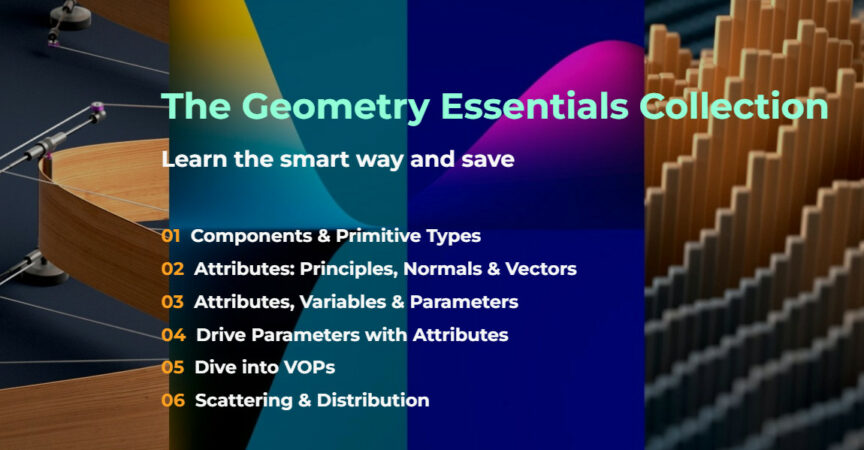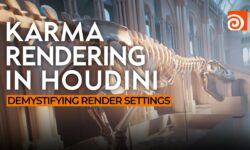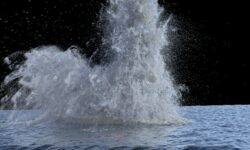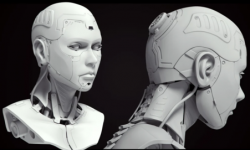The Geometry Essentials Collection 1-6 (Houdini)
Release date:2022, September
Author:Hipflask
Skill level:Beginner
Language:English
Exercise files:Yes
Learn it all, for less
Houdini isn’t so hard to master when you’re carefully guided through it. Our learning path is designed to step you through what you need to learn, in the order you need to learn it.
All of our current Geometry Essentials courses are packaged into this one comprehensive collection. 212 in-depth tutorials, over 18.5 hours of learning – this isn’t a quick how-to guide that teaches you to make one thing. We unpack the vital stuff other courses breeze over, covering the fundamentals in depth, showing you why these principles are so integral to Houdini and just how to wield them. Each course builds on the last, arming you with the technical knowledge to craft, finesse and refine original pieces.
But we don’t waste time either. Your learning time is precious and we know it. That’s why we make sure every second of these 6 courses contains the most crucial information, carefully explained, and delivered at the right time, in a way you’ll remember for the long term. We’re about true depth of understanding, not a few weak tricks.
This bundle is everything you need to start learning Houdini the right way. And you get a massive 30% saving to boot.
Houdini Geometry Essentials 01 – Components & Primitive Types
01. Creating Primitive Geometry
01. Creating Primitive Geometry – Create at object level vs create in context
02. Creating Primitive Geometry Objects – Viewport Handles
02. Geometry Components
03. Geometry Components Part 01 – Points, Edges, and Primitives
04. Geometry Components Part 02 – Vertices
05. Component Numbers
03. Connecting Points
06. Connecting Points – Curves
07. Disconnecting and Reconnecting Points
08. Vertices Control Connectivity
09. Connecting Points – Particles to Surfaces
04. Primitive Types – Polygons
10. Closed Curves are also Polygon Surfaces
11. Every Polygon Face is also a Closed Curve
12. Drawing and Editing Polygons Using the Curve SOP – Part 1
13. Drawing and Editing Polygons Using the Curve SOP – Part 2
14. Drawing and Editing Polygons Using the Curve SOP – Part 3
15. Open and Closed Polygons – Part 1 – The Ends SOP
16. Open and Closed Polygons – Part 2 – The Crucial Role of Vertices
17. Open and Closed Polygons – Part 3 – Rendering Curves
18. Open and Closed Polygons – Part 4 – Rendering Wireframe Geometry
19. Polymodelling Tools on Polygon Curves
20. Polygon options on Primitive Object Nodes
05. Bezier Curves – Drawing, Editing and Modelling
21. Drawing Bezier Curves
22. Editing Bezier Curves – Points and Tangency
23. Editing Bezier Curves – Segments
24. Editing Bezier Curves – Rounded Corners
25. Working with Bezier Curves – Reference Images
26. Working with Bezier Curves – Tracing a Profile
27. Working with Bezier Curves – Modelling
28. Working with Bezier Curves – Resampling Bezier Curves to Polygons
29. Optimising Curves with the Refine SOP
06. The Technical Side of Bezier Curves
30. How Bezier Curves work – Order and Degree
31. How Bezier Curves work – Components
32. Editing Bezier Curves – Curve SOP vs Edit SOP
33. Editing Bezier Curves – Procedural Nodes vs Non-Procedural Nodes
34. Editing Curves Procedurally
35. Animating Curves
07. Primitive Types – Nurbs Curves
36. Comparing Nurbs Curves to Bezier Curves
37. Nurbs Curves – Order – Part 1
38. Nurbs Curves – Order – Part 2
39. Drawing and Editing Nurbs Curves Using the Curve Node
40. Nurbs Curves – Point Weight
08. Parametric Curves and Surfaces
41. Auto Bezier Draw Mode
42. Generating Nurbs and Bezier Curves Procedurally – The Fit Node
43. Parametric Space
44. Parameterisation – Part 1 – Uniform vs Chord Length
45. Parameterisation – Part 2 – Chord Length and Centripetal
46. Nurbs and Bezier Surfaces – Part 1 – Cross Section Curves
47. Nurbs and Bezier Surfaces – Part 2 – Parametric Space
09. Comparing & Converting Nurbs & Polygons
48. Comparing Nurbs and Bezier Curves to Polygon Curves
49. Using Polygon Curves Like Nurbs Curves – Subdivision Curves
50. Interpolating Curves – Nurbs and Beziers vs Polygons
51. Converting Polygon Faces to Nurbs Surfaces
52. Bilinear Mesh
10. Primitive Types – Polysoups & Quadratic Primitives
53. Polygon Soups Part 01 – Memory and Disk Space
54. Polygon Soups Part 02 – Benefits and Limitations
55. Quadratic Primitives
Houdini Geometry Essentials 02 – Attributes – Principles, Normals & Vectors
01. Principles
01. What Are Attributes
02. An Analogy For Attributes
03. The Position Attribute and the Geometry Spreadsheet
04. Attribute Class
05. Creating and Manipulating Attributes
06. Attribute Types
07. Attribute Create Node
08. Attribute Type Qualifier – Attribute Meaning
02. The Normal Attribute
09. What Are Normals
10. Calculating and Adding Vertex Normals
11. Normal Weighting Methods
03. Visualising Attributes
12. Creating Attribute Visualisers
13. Remapping Values and Per Component Ramps
14. Using Colour to Visualise Normal Interpolation Across Primitives
04. Auto Generation and Attribute Defaults
15. Adding The Normal Attribute vs Auto Generate
16. Attribute Mismatch
17. Default Attribute Values
05. Vectors
18. Drawing Vectors
19. Vector Visualisation – Markers
20. Unit Vectors
21. Unit Vectors Part 02
06. Normals for Orientation
22. The Copy To Points Node
23. Using Normals to Orientate Geometry
24. Adding Randomisation to Attributes
25. Attribute Randomise – Visualising the Distribution
07. Reversing and Correcting Normals
26. Polygon Winding Order
27. Reversing Vertex Order Using the Reverse Node
28. Shifting the Vertex Order
29. Reversing Vertex Order Vs Reversing Normals – Part 01
30. Reversing Vertex Order Vs Reversing Normals – Part 02
31. Correcting Primitive Normals
Houdini Geometry Essentials 03 – Attributes, Variables & Parameters
01. Variables
01. Global Variables as Shorthand for Constant Values
02. Global Variables – A Constant Name for Changing Values
03. Local Variables
04. Global & Local Variables in the Output Context
05. Local Variables Take Precedence Over Global Variables
02. Bounding Box Variables
06. What exactly is the Bounding Box
07. Min and Max Local Variables on the Transform Node
08. Transform Local Variables and the Match Size Node
09. Using Attributes and Local Variables in Parameter Expressions
10. Relative Bounding Box Using Local Variables
03. Referencing Parameters and Bounding Box Values
11. Project & System Overview
12. Channel References
13. HScript Bounding Box Expression
14. The Advantage of Referencing Nulls
15. Importance of Positioning Geometry
16. Aligning with the Origin
17. Organising The Network
04. Understanding Orientation Along Curves
18. Copying to First and Last Points
19. Using Polyframe to Orientate the Copied Geometry
20. Orientation Along Curve and the Order of Operations
21. Understanding the Up Vector
22. Computing and Controlling the Up Vector
23. Leveraging the Primary and Secondary Axis
24. Manipulating the Normal Attribute
05. Distributing with Precision
25. Controlling Distribution Using the Resample Length
26. Tangent Type and Arc Length vs Chord Length Measurement Method
27. Justifying the Copy on the First Point
28. Justifying the Copy on the Last Point
06. Resampling & Raying
29. Resampling the Planar Curve
30. Using the Ray Node to Deal with Elevation
31. Resampling Twice for Greater Precision
32. Raying Back onto the Input Curve
33. Ray Tolerance and Treating Polygons as Straight Edges
34. Maintaining the Last Vertex
07. Spare Parameters & Randomisation
35. Adding Spare Parameters to Nodes
36. Resampling by Polygon Edge
37. Adding Normals and Handling Attribute Mismatches
38. Randomising Scale and Position
39. Randomising Orientation
08. Putting it into Practice
40. Environment Layout Tasks & Object Merge
41. Creating Curves from Edge Selections & the Output Node
42. Resample – Arc Length and Even Last Segment
43. Creating a Post & Rail Fence
44. Using the Sweep Node to Add the Rails
45. Using Normal & Up Attributes with the Sweep Node
46. Offsetting the Curve using the Poly Extrude Node
47. Poly Extrude – Extrude Along Edge Normal vs Front Transform
48. Using the Carve Node to Shorten the Curve
49. Using the Stacking System to Build Street Lamps
50. Distributing the Street Lamps
Houdini Geometry Essentials 04 – Drive Parameters with Attributes
01. Referencing Attributes in Parameters
01. Using @attribute Notation Within Parameters
02. @attibute on Newer Nodes and in Group Parameter Fields
03. Accessing Detail Attributes Using an Expression Function
04. Using an Expression Function to Access Primitive Attributes
05. The Benefit of Using Relative Paths
06. When its Better to Use Absolute Paths
02. Using Attribute Expressions
07. Creating the Geometry
08. Calculating the Circumference Using the Measure Node
09. Creating the Rotation to Linear Motion Expression
10. Deforming the Sheet Around the Roller
11. Testing and Animating The Setup
03. Scaling Parameters by Attribute
12. Generating Distance and Mask Attributes
13. Transforming Points by Attribute Value
14. Animating the Attribute Values
15. Using a Ramp Parameter to Remap Attribute Values
16. Extruding Primitives by Attribute Value
17. Using the Resample Node to Generate a CurveU Attribute
18. Bevelling Edges by Attribute Value
19. Modifying Attribute Values Using the Attribute Adjust Node
20. Reviewing the Workflow of Generating, Modifying and Using Attributes
Houdini Geometry Essentials 05 – Dive into VOPs
01. The Case For VEX
01. VEX Performance Comparison Setup
02. Using the Performance Monitor
03. Explaining the Results
02. VOPs – Running Over Components & Geometry Globals
04. Running Over Geometry Components
05. The Position Variable
06. Attribute Inputs & Outputs and Data Type Colours
07. Time Global Variables and Converting from Float to Vector
03. Moving Points, Retiming Values, and Scaling Over Time
08. Displacing Points Using a Texture Map
09. Isolating Colour Components and Computing Luminance
10. Retiming Attribute Values Using the Retime Node
11. Scaling Values Over Time
12. Clamping Values and Deleting Attributes
04. Visualising & Manipulating Vectors in VOPs – Direction & Magnitude
13. Visualising Attributes in VOPs
14. Using Velocity to Orientate Copies
15. Fitting Values to a New Range
16. Normalising Vectors & Computing Vector Length
05. Binding, Indexing & Identifying by Attribute
17. Binding Attributes Part 01
18. Binding Attributes Part 02 – Exporting
19. Indexing Variables Part 1 – ptnum, primnum, vtxnum
20. Indexing Variables Part 2 – numpt, numprim, numvxt
21. Adding Polygons by Point Attribute
22. Selecting and Splitting Geometry by Attribute
06. Indexing, Point Sorting & the 0-1 Range
23. Using Point Index to Generate a Curve U Coordinate
24. A Benefit of Working With Normalised 0-1 Values
25. Scaling Using the Match Size Node
26. Scaling to a Given Size Using the Transform Node
27. Point Sorting
28. Working With the Vertex Index
07. Controlling Banking & Working With Parameter VOPs
29. Using the Path Deform Node to Move Geometry Along a Curve
30. Measuring Curvature
31. Blending Vectors in VOPs
32. When and Why to use Parameter VOPs
33. Animating VOP Parameters
34. Naming, Labelling and Setting Parameter Defaults
35. The Importance of Naming Parameters
08. Displacement, Ramp Parameters & Noise
36. The Displace Along Normal VOP
37. The Relative to Bounding Box VOP
38. The Ramp Parameter VOP
39. An Introduction to Noise
40. Promoting and Referencing VOP Parameters
41. Noise – Frequency and Offset
42. Noise – Fractal Parameters
43. Noise – Fractal Types
44. Noise – Remapping & Correcting the Output
Houdini Geometry Essentials 06 – Scattering & Distribution
01. Noise vs Random
01. Graphing the Outputs
02. Relationships and Trends
03. The Organic Nature of Noise
04. Comparing the Distribution Ranges
02. Distribution & Density
05. Exercise Intro & Scattering Points
06. Running Over Numbers & the Clumping Nature of the Random Function
07. Point Relaxing
08. Working with Point Density
09. Controlling Point Density with Attributes
03. Correcting, Adjusting & Compositing Attributes
10. Geometry Resolution and Attributes
11. Comparing Attribute Values to Pixel Values
12. Correcting the Noise Output – Colour Correct & Levels
13. Correcting The Noise Output – Curves & Ramps
14. Compositing Attributes
15. Working with the Mask Controls
04. The Relationship Between Attribute VOPs and Attribute SOPs
16. Replacing an Attribute VOP
17. Houdini as a Framework for Creating 3D Tools
18. Using Noise to Control Size
05. Controlling Random Distribution
19. Randomising the Scale Attribute in VOPs
20. Controlling Random Distribution Using Bias & Gain
21. Graphing the Bias & Gain Controls
22. Controlling Random Distribution Using a Ramp Parameter
23. Comparing the Custom Built SOP to the Attribute Randomise SOP
06. The Scatter & Align SOP
24. Scattering Points
25. Randomising Rotation
26. The Orient Attribute
27. Adding Attributes to Existing Point Clouds
07. Testing & Optimising
28. Distributing on Different Terrains & Objects
29. Optimising the System – Order of Operations
30. Optimising the System – Region of Interest
31. Summary
[Hipflask] The Geometry Essentials Collection 1-6 (Houdini).7z
[Hipflask] The Geometry Essentials Collection 1-6 (Houdini)_Subtitles.7z





 Channel
Channel






Will you share the other courses by Hipflask by chance? Thank you!